Shoreline Rotation Analysis of Embayed Beaches by Means of In Situ and Remote Surveys
Abstract
:1. Introduction
2. Study Area
3. Methodology
3.1. Beach Characterization and Shoreline Detection
3.1.1. Orthophoto Processing
3.1.2. DGPS Surveys
3.2. Beach Rotation
3.3. UAV and SAR Remote Surveys for Coastline Evolution
3.3.1. UAV Measurements
3.3.2. SAR Observations
4. Results
4.1. Beach Characterization
4.2. Wave Climate
4.3. Shoreline Evolution
4.3.1. Serapo Beach
- 1954–2006 (52 years).Figure 8a shows a generalized beach advance, with a maximum in 2006 (green line), particularly for the western and eastern extremities.1954–2000 (Figure 9a): An inhomogeneous shoreline advance of between a few meters in the western to approx. 30 m in the eastern sector affects the beach.2000–2006 (Figure 9b): The western sector clearly advances, while the eastern sector retreats. This coincides with an anticlockwise rotation of the beach around a virtual pivotal point near transect 5.1954–2006 (Figure 9c): The overall result for this period is the sum of the precedent, contrasting ones, i.e., a moderate increase in the beach width in both the western and eastern sectors.
- 2006–2013 (8 years).2006–2008 (Figure 9d): A consistent erosion affects the western sector (max. ca. 18.5 m, transect 1), contrasting a progradation of up to 18 m in the eastern sector. A clockwise rotation of the beach around virtual pivotal point located near transect 5 occurs.2008–2013 (Figure 9e): rather homogeneous retreat affects the entire coast, with values comprised between about 10 and 25 m, slightly more intense in the eastern sector.2006–2013 (Figure 9f): A significant erosion of the entire beach occurs, with maximum values of more than 30 m in the western sector and around 15 in the eastern sector. In the central part of the beach shoreline retreat is more modest, max. 10–11 m (transects 6–9).
- 1954–2018 (62 years). The graphical result given in Figure 8a shows a general beach recovery, more significant for the eastern sector, in which the 2018 coastline (black line) is more detached from the 2013 coastline (yellow line). Figure 9 again confirms this result, with the evolution 2013–2018 reported in (h).1954–2013 (Figure 9g): This period sums up the two previous major periods 1954–2006 and 2006–2013 (Figure 9c,f). The result is a slight retreat of the western sector, and some small advance of part of the eastern sector that “preserves” part of the clockwise rotation occurred in 2006–2008.2013–2018 (Figure 9h): There is a moderate and irregular beach recovery with values of 5 to 15 m, slightly more consistent in the eastern sector.1954–2018 (Figure 9i): The overall result is a net clockwise rotation of the beach around a central virtual pivotal point (transect 7), with an overall slight shoreline retreat in the western sector (max. values around 5 m) and a net, although irregular progradation of the eastern sector.
4.3.2. S. Agostino Beach
- 1954–2006 (52 years).Figure 8b shows the stability of the whole beach due to an advance in 2000 (blue line) followed by a retreat in 2006 (green line).1954–2000 (Figure 10a): A consistent shoreline advance affects the beach extremities with maximum values of 20–30 m in the north-western sector (transects 1–5).2000–2006 (Figure 10b): Retreat affects nearly all the beach, more pronounced in the north-western sector (max. values of 30 m). An initial clockwise rotation of the beach is the result.1954–2006 (Figure 10c): The beach has advanced along the extremities, especially in the south-eastern sector with max. values of ca. 20 m.
- 2006–2013 (8 years).2006–2008 (Figure 10d): The beach slightly retreats in the north-western sector, and advances in the south-eastern sector. A slight clockwise beach rotation is the result.2008–2013 (Figure 10e): A retreat of the entire beach occurs, much more pronounced in the south-eastern sector. The result is a slight anticlockwise rotation with a virtual point located in the central part of the beach.2006–2013 (Figure 10f): The sum of the two contrasting precedent shoreline rotations is an overall shoreline retreat, more intense in the south-eastern sector.
- 1954–2018 (62 years).The inspection of Figure 8b does not help to identify a clear trend.1954–2013 (Figure 10g): The beach is stable along the extremities and retreats in the central part.2013–2018 (Figure 10h): There is some irregular beach recovery with maximum values around 10 m.1954–2018 (Figure 10i): The beach is globally stable, the base line in 2018 practically coincides with that of 2018.
4.4. Validation of UAV and SAR Remote Surveys with DGPS
5. Discussion
6. Conclusions
Author Contributions
Funding
Acknowledgments
Conflicts of Interest
References
- Small, C.; Nicholls, R.J. A global analysis of human settlement in coastal zones. JSTOR 2003, 19, 584–599. [Google Scholar]
- Pikelj, K.; Ružić, I.; Ilić, S.; James, M.R.; Kordić, B. Implementing an efficient beach erosion monitoring system for coastal management in Croatia. Ocean Coast. Manag. 2018, 156, 223–238. [Google Scholar] [CrossRef]
- Guariglia, A.; Buonamassa, A.; Losurdo, A.; Saladino, R.; Trivigno, M.L.; Zaccagnino, A.; Colangelo, A. A multisource approach for coastline mapping and identification of shoreline changes. Ann. Geophys. 2006, 49, 295–340. [Google Scholar]
- Alesheikh, A.A.; Ghorbanali, A.; Nouri, N. Coastline change detection using remote sensing. Int. J. Environ. Sci. Technol. 2007, 4, 61–66. [Google Scholar] [CrossRef] [Green Version]
- Nunziata, F.; Buono, A.; Migliaccio, M.; Benassai, G. Dual-polarimetric C-and X-band SAR data for coastline extraction. IEEE J. Sel. Top. Appl. Earth Obs. Remote Sens. 2016, 9, 4921–4928. [Google Scholar] [CrossRef]
- Benassai, G.; Aucelli, P.; Budillon, G.; De Stefano, M.; Di Luccio, D.; Di Paola, G.; Montella, R.; Mucerino, L.; Sica, M.; Pennetta, M. Rip current evidence by hydrodynamic simulations, bathymetric surveys and UAV observation. Nat. Hazards Earth Syst. Sci. 2017, 17, 1493–1503. [Google Scholar] [CrossRef] [Green Version]
- Brignone, M.; Schiaffino, C.F.; Isla, F.I.; Ferrari, M. A system for beach video-monitoring: Beachkeeper plus. Comput. Geosci. 2012, 49, 53–61. [Google Scholar] [CrossRef]
- Di Luccio, D.; Benassai, G.; Budillon, G.; Mucerino, L.; Montella, R.; Pugliese Carratelli, E. Wave run-up prediction and observation in a micro-tidal beach. Nat. Hazards Earth Syst. Sci. 2018, 18, 2841–2857. [Google Scholar] [CrossRef]
- Aarninkhof, S.G.J. Nearshore Bathymetry Derived from Video Imagery; Delft University Press: Delft, The Netherlands, 2003. [Google Scholar]
- Turner, I.L.; Aarninkhof, S.; Dronkers, T.; McGrath, J. CZM applications of Argus coastal imaging at the Gold Coast, Australia. J. Coast. Res. 2004, 34, 739–752. [Google Scholar] [CrossRef]
- Holman, R.A.; Stanley, J. The history and technical capabilities of Argus. Coast. Eng. 2007, 54, 477–491. [Google Scholar] [CrossRef]
- Di Paola, G.; Aucelli, P.P.C.; Benassai, G.; Rodríguez, G. Coastal vulnerability to wave storms of Sele littoral plain (Southern Italy). Nat. Hazards 2014, 71, 1795–1819. [Google Scholar] [CrossRef]
- Benassai, G.; Di Paola, G.; Aucelli, P.P.C. Coastal risk assessment of a micro-tidal littoral plain in response to sea level rise. Ocean Coast. Manag. 2015, 104, 22–35. [Google Scholar] [CrossRef]
- Aucelli, P.P.C.; Di Paola, G.; Incontri, P.; Rizzo, A.; Vilardo, G.; Benassai, G.; Buonocore, B.; Pappone, G. Coastal inundation risk assessment due to subsidence and sea level rise in a Mediterranean alluvial plain (Volturno coastal plain–southern Italy). Estuar. Coast. Shelf Sci. 2017, 198, 597–609. [Google Scholar] [CrossRef]
- Di Luccio, D.; Benassai, G.; Di Paola, G.; Rosskopf, C.; Mucerino, L.; Montella, R.; Contestabile, P. Monitoring and Modelling Coastal Vulnerability and Mitigation Proposal for an Archaeological Site (Kaulonia, Southern Italy). Sustainability 2018, 10, 2017. [Google Scholar] [CrossRef]
- Short, A.; Masselink, G.E. Structurally Controlled Beaches. In Handbook of Beach and Shoreface Morphodynamics; Short, A.D., Ed.; John Wiley and Sons Ltd.: Chichester, UK, 1999; pp. 230–250. [Google Scholar]
- Da Fontoura Klein, A.H.; Benedet Filho, L.; Schumacher, D.H. Short-term beach rotation processes in distinct headland bay beach systems. J. Coast. Res. 2002, 18, 442–458. [Google Scholar]
- Martins, C.C.; de Mahiques, M.M.; Dias, J.M.A. Daily morphological changes determined by high-energy events on an embayed beach: A qualitative model. Earth Surf. Process. Landf. 2010, 35, 487–495. [Google Scholar] [CrossRef]
- Ojeda, E.; Guillén, J. Shoreline dynamics and beach rotation of artificial embayed beaches. Mar. Geol. 2008, 253, 51–62. [Google Scholar] [CrossRef]
- Bryan, K.; Gallop, S.; van de Lageweg, W.; Coco, G. Observations of rip channels, sandbar-shoreline coupling and beach rotation at Tairua Beach, New Zealand. In Coasts and Ports 2009: In a Dynamic Environment; Engineers Australia: Barton, Australia, 2009; p. 270. [Google Scholar]
- Short, A.; Cowell, P.; Cadee, M.; Hall, W.; Van Dijk, B. Beach rotation and possible relation to the Southern Oscillation. In Proceedings of the Ocean and Atmospheric Pacific International Conference, Adelaide, Australia, 23–27 October 1995; pp. 329–334. [Google Scholar]
- Masselink, G.; Pattiaratchi, C. Seasonal changes in beach morphology along the sheltered coastline of Perth, Western Australia. Mar. Geol. 2001, 172, 243–263. [Google Scholar] [CrossRef]
- Simeoni, U.; Corbau, C.; Pranzini, E.; Ginesu, S. Le Pocket Beach. Dinamica e Gestione Delle Piccole Spiagge: Dinamica e Gestione Delle Piccole Spiagge; FrancoAngeli: Milan, Italy, 2012. [Google Scholar]
- Harley, M.D.; Turner, I.L.; Short, A.D.; Ranasinghe, R. Assessment and integration of conventional, RTK-GPS and image-derived beach survey methods for daily to decadal coastal monitoring. Coast. Eng. 2011, 58, 194–205. [Google Scholar] [CrossRef]
- Turki, I.; Medina, R.; Gonzalez, M.; Coco, G. Natural variability of shoreline position: Observations at three pocket beaches. Mar. Geol. 2013, 338, 76–89. [Google Scholar] [CrossRef]
- Benassai, G.; Migliaccio, M.; Montuori, A. Sea wave numerical simulations with COSMO-SkyMed© SAR data. J. Coast. Res. 2013, 65, 660–665. [Google Scholar] [CrossRef]
- Benassai, G.; Montuori, A.; Migliaccio, M.; Nunziata, F. Sea wave modeling with X-band COSMO-SkyMed© SAR-derived wind field forcing and applications in coastal vulnerability assessment. Ocean Sci. 2013, 9, 325–341. [Google Scholar] [CrossRef] [Green Version]
- Benassai, G.; Di Luccio, D.; Migliaccio, M.; Cordone, V.; Budillon, G.; Montella, R. High resolution remote sensing data for environmental modelling: Some case studies. In Proceedings of the 2017 IEEE 3rd International Forum on Research and Technologies for Society and Industry (RTSI), Modena, Italy, 11–13 September 2017; pp. 1–5. [Google Scholar]
- Benassai, G.; Stenberg, C.; Christoffersen, M.; Mariani, P. A Sustainability Index for Offshore Wind Farms and Open Water Aquaculture; WIT Press: Southampton, UK, 2011; pp. 3–14. [Google Scholar]
- Nunziata, F.; Buono, A.; Migliaccio, M. COSMO—SkyMed Synthetic Aperture Radar Data to Observe the Deepwater Horizon Oil Spill. Sustainability 2018, 10, 3599. [Google Scholar] [CrossRef]
- Di Donato, P.; Buono, A.; Poli, A.; Finore, I.; Abbamondi, G.; Nicolaus, B.; Lama, L. Exploring Marine Environments for the Identification of Extremophiles and Their Enzymes for Sustainable and Green Bioprocesses. Sustainability 2019, 11, 149. [Google Scholar] [CrossRef]
- De Pippo, T.; Donadio, C.; Miele, P.; Valente, A. Morphological evidence for late Quaternary tectonic activity along the coast of Gaeta (central Italy). Geogr. Fis. Din. Quat. 2007, 30, 43–53. [Google Scholar]
- Manno, G.; Lo Re, C.; Ciraolo, G. Shoreline detection in gentle slope Mediterranean beach. In Proceedings of the 5th SCACR—International Short Conference on Applied Coastal Research, Aachen, Germany, 6–9 June 2011. [Google Scholar]
- ASTM. Standard Practice for Dry Preparation of Soil Samples for Particle-Size Analysis and Determination of Soil Constants. Available online: http://www.astm.org/Standards/D421.htm (accessed on 1 September 2018).
- ASTM. Standard test method for particle-size analysis of soils. In Annual Book of ASTM Standards; ASTM: West Conshohocken, PA, USA, 2007. [Google Scholar]
- Boak, E.H.; Turner, I.L. Shoreline definition and detection: A review. J. Coast. Res. 2005, 21, 688–703. [Google Scholar] [CrossRef]
- Anders, F.J.; Byrnes, M.R. Accuracy of shoreline change rates as determined from maps and aerial photographs. Shore Beach 1991, 59, 17–26. [Google Scholar]
- Byrnes, M.R.; McBride, R.A.; Hiland, M.W. Accuracy standards and development of a national shoreline change data base. In Coastal Sediments; ASCE: Reston, VA, USA, 1991; pp. 1027–1042. [Google Scholar]
- Crowell, M.; Leatherman, S.P.; Buckley, M.K. Historical shoreline change: Error analysis and mapping accuracy. J. Coast. Res. 1991, 7, 839–852. [Google Scholar]
- Del Río, L.; Gracia, F.J.; Benavente, J. Shoreline change patterns in sandy coasts. A case study in SW Spain. Geomorphology 2013, 196, 252–266. [Google Scholar] [CrossRef] [Green Version]
- Alberico, I.; Amato, V.; Aucelli, P.P.C.; D’argenio, B.; Di Paola, G.; Pappone, G. Historical shoreline change of the Sele Plain (Southern Italy): The 1870–2009 time window. J. Coast. Res. 2012, 28, 1638–1647. [Google Scholar] [CrossRef]
- Morton, R.A.; Leach, M.P.; Paine, J.G.; Cardoza, M.A. Monitoring beach changes using GPS surveying techniques. J. Coast. Res. 1993, 9, 702–720. [Google Scholar]
- Martínez del Pozo, J.; Anfuso, G. Spatial approach to medium-term coastal evolution in south Sicily (Italy): Implications for coastal erosion management. J. Coast. Res. 2008, 24, 33–42. [Google Scholar] [CrossRef]
- Nunziata, F.; Migliaccio, M.; Brown, C.E. Reflection symmetry for polarimetric observation of man-made metallic targets at sea. IEEE J. Ocean. Eng. 2012, 37, 384–394. [Google Scholar] [CrossRef]
- Buono, A.; Nunziata, F.; Mascolo, L.; Migliaccio, M. A multipolarization analysis of coastline extraction using X-band COSMO-SkyMed SAR data. IEEE J. Sel. Top. Appl. Earth Obs. Remote Sens. 2014, 7, 2811–2820. [Google Scholar] [CrossRef]
- Ding, X.; Nunziata, F.; Li, X.; Migliaccio, M. Performance analysis and validation of waterline extraction approaches using single-and dual-polarimetric SAR data. IEEE J. Sel. Top. Appl. Earth Obs. Remote Sens. 2015, 8, 1019–1027. [Google Scholar] [CrossRef]
- Maini, R.; Aggarwal, H. Study and comparison of various image edge detection techniques. Int. J. Image Process. 2009, 3, 1–11. [Google Scholar]
- Ferrentino, E.; Nunziata, F.; Migliaccio, M. Full-polarimetric SAR measurements for coastline extraction and coastal area classification. Int. J. Remote Sens. 2017, 38, 7405–7421. [Google Scholar] [CrossRef]
- Geudtner, D.; Torres, R.; Snoeij, P.; Davidson, M.; Rommen, B. Sentinel-1 system capabilities and applications. In Proceedings of the 2014 IEEE Geoscience and Remote Sensing Symposium, Quebec City, QC, Canada, 13–18 July 2014; pp. 1457–1460. [Google Scholar]
- Bencivenga, M.; Nardone, G.; Ruggiero, F.; Calore, D. The Italian data buoy network (RON). Adv. Fluid Mech. IX 2012, 74, 321. [Google Scholar]
- Harley, M.D.; Andriolo, U.; Armaroli, C.; Ciavola, P. Shoreline rotation and response to nourishment of a gravel embayed beach using a low-cost video monitoring technique: San Michele-Sassi Neri, Central Italy. J. Coast. Conserv. 2014, 18, 551–565. [Google Scholar] [CrossRef]
- Modava, M.; Akbarizadeh, G. Coastline extraction from SAR images using spatial fuzzy clustering and the active contour method. Int. J. Remote Sens. 2017, 38, 355–370. [Google Scholar] [CrossRef]
- Akbarizadeh, G.; Rahmani, M. Efficient combination of texture and color features in a new spectral clustering method for PolSAR image segmentation. Nat. Acad. Sci. Lett. 2017, 40, 117–120. [Google Scholar] [CrossRef]
- Kim, D.J.; Moon, W.M.; Park, S.E.; Kim, J.E.; Lee, H.S. Dependence of Waterline Mapping on Radar Frequency Used for SAR Images in Intertidal Areas. IEEE Geosci. Remote Sens. Lett. 2007, 4, 269–273. [Google Scholar] [CrossRef]
- Montella, R.; Ferraro, C.; Kosta, S.; Pelliccia, V.; Giunta, G. Enabling android-based devices to high-end gpgpus. In International Conference on Algorithms and Architectures for Parallel Processing; Springer: Berlin/Heidelberg, Germany, 2016; pp. 118–125. [Google Scholar]
- Montella, R.; Kosta, S.; Oro, D.; Vera, J.; Fernández, C.; Palmieri, C.; Di Luccio, D.; Giunta, G.; Lapegna, M.; Laccetti, G. Accelerating Linux and Android applications on low-power devices through remote GPGPU offloading. Concurr. Comput. Pract. Exp. 2017, 29, e4286. [Google Scholar] [CrossRef]
- Laccetti, G.; Montella, R.; Palmieri, C.; Pelliccia, V. The high performance internet of things: Using GVirtuS to share high-end GPUs with ARM based cluster computing nodes. In International Conference on Parallel Processing and Applied Mathematics; Springer: Berlin/Heidelberg, Germany, 2013; pp. 734–744. [Google Scholar]
- Montella, R.; Di Luccio, D.; Troiano, P.; Riccio, A.; Brizius, A.; Foster, I. WaComM: A parallel Water quality Community Model for pollutant transport and dispersion operational predictions. In Proceedings of the 2016 12th International Conference on Signal-Image Technology & Internet-Based Systems (SITIS), Naples, Italy, 28 November–1 December 2016; pp. 717–724. [Google Scholar]

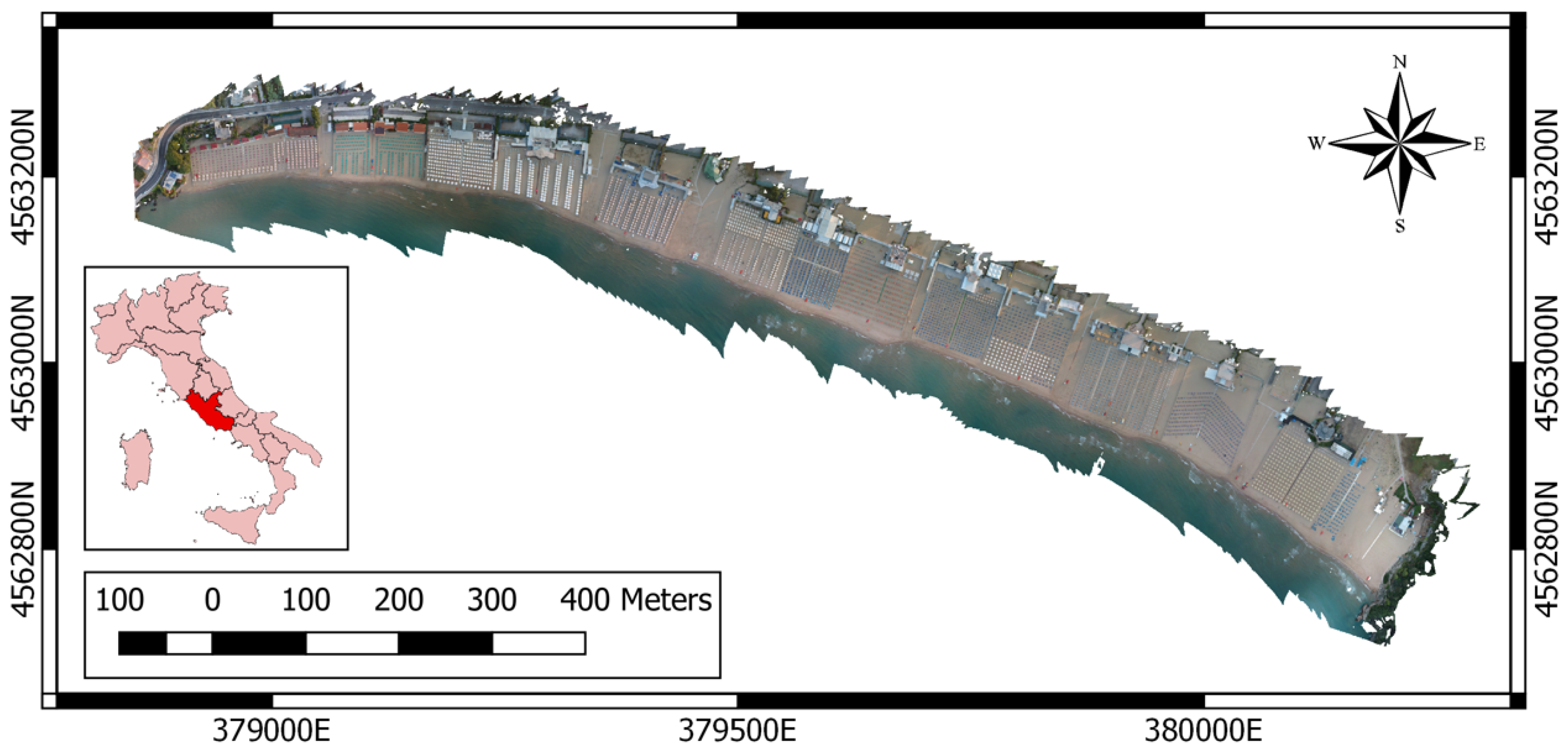
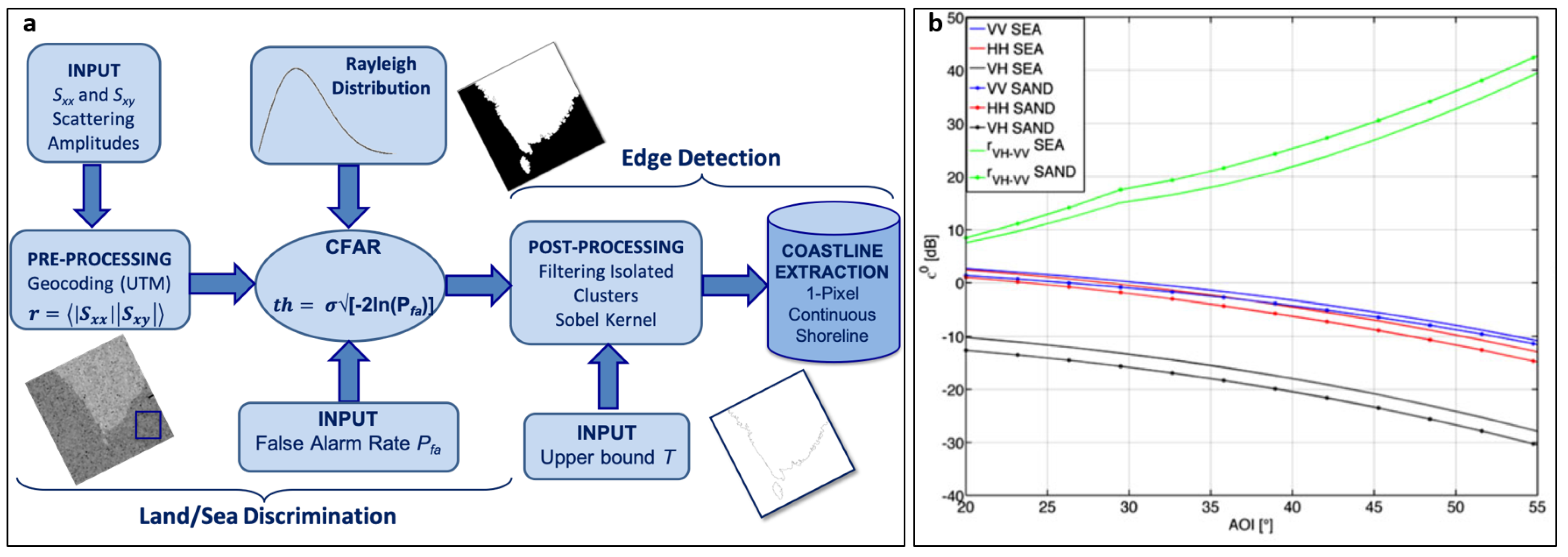
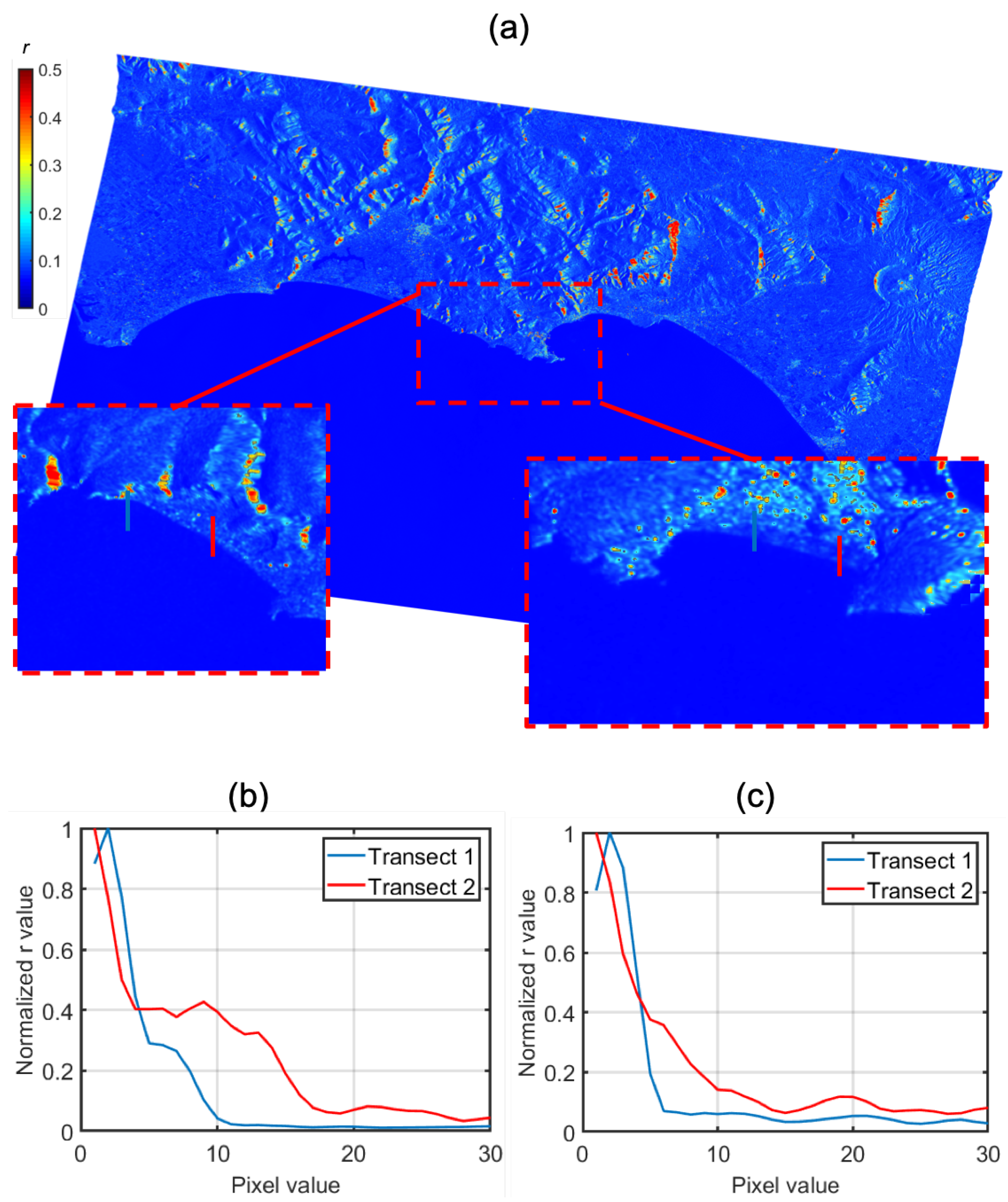

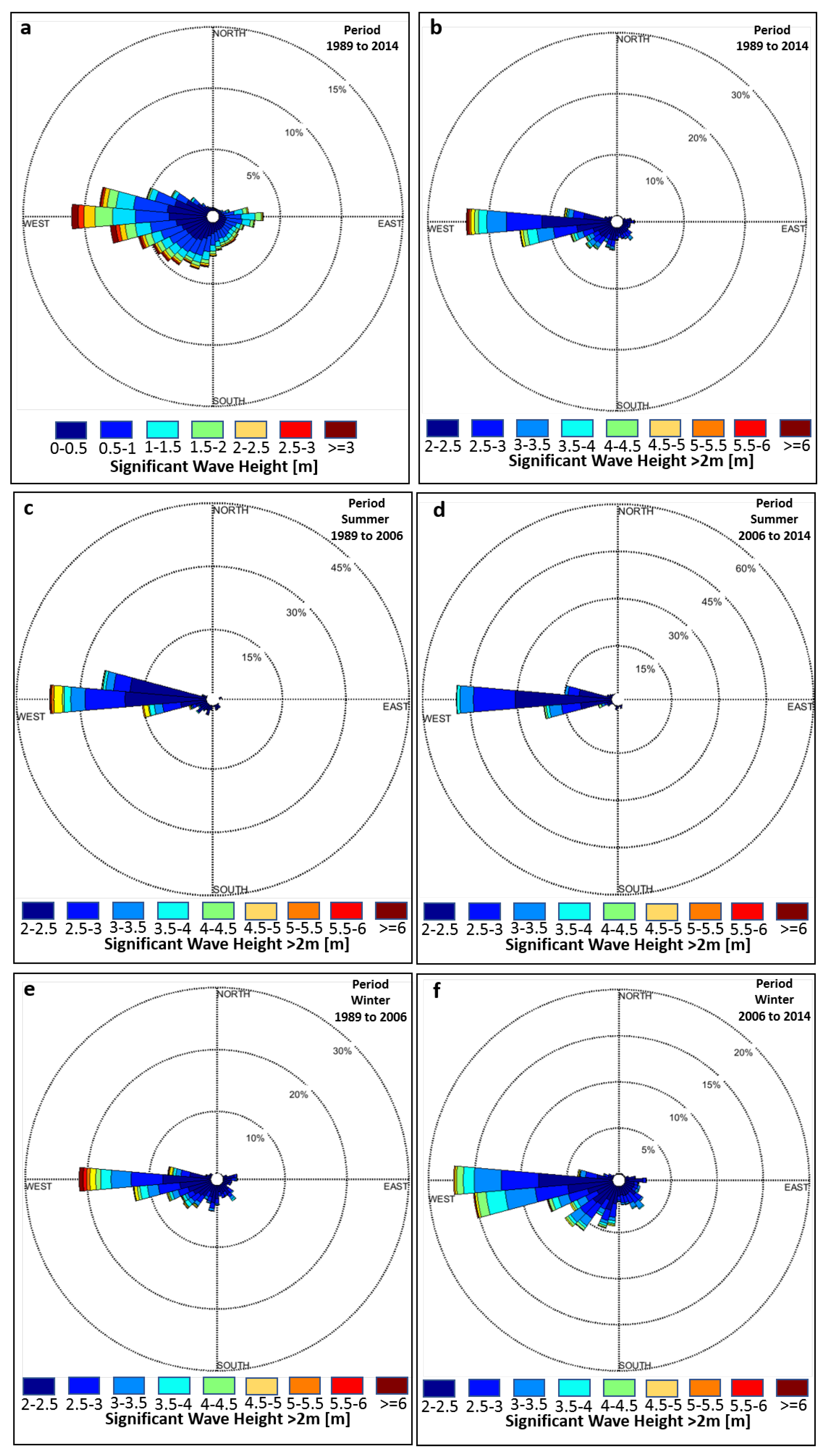


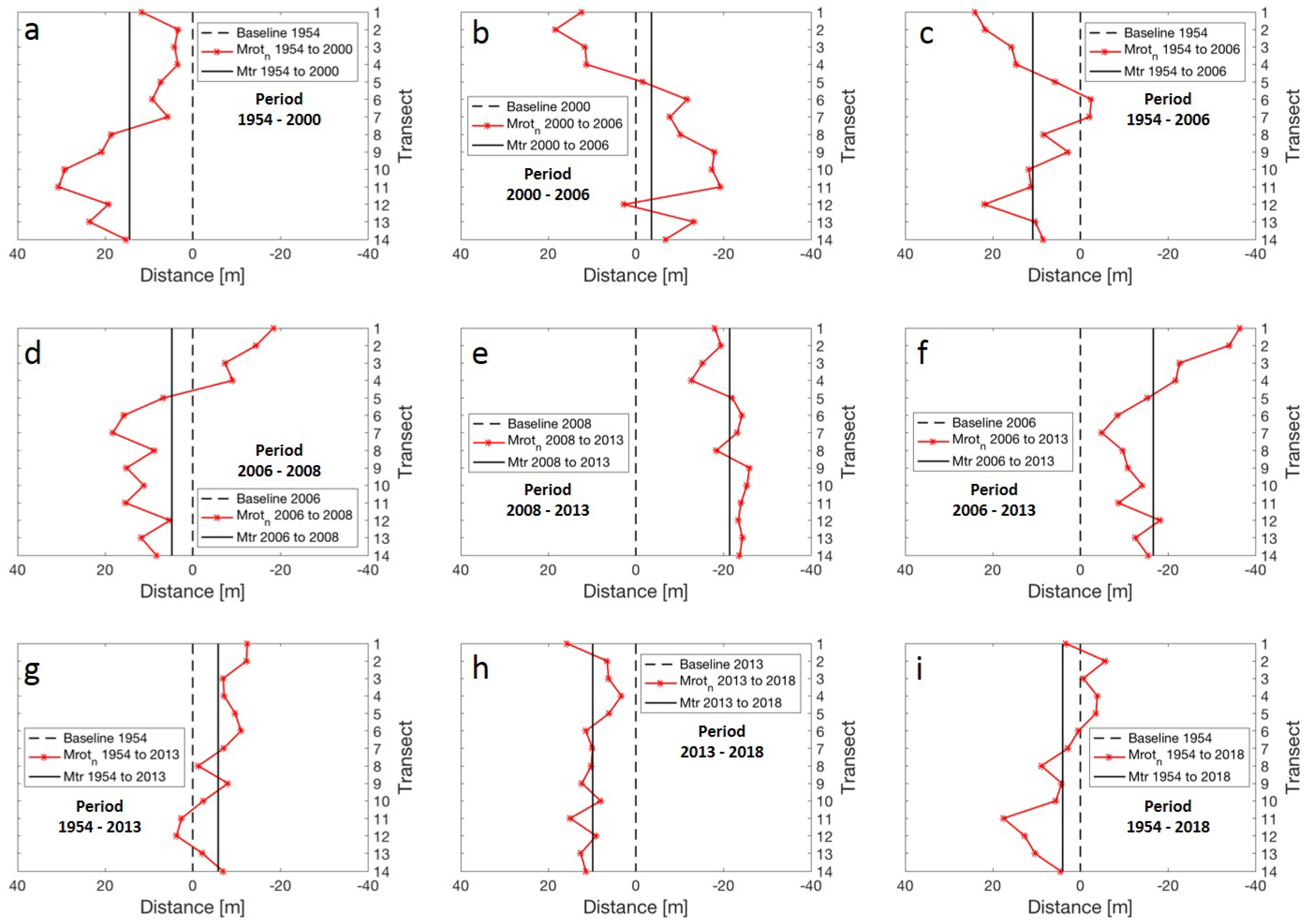


| Number of Scenes | Acquisition Period | Band | Polarization | AOI () | Swath (km) | Pixel Spacing (m) |
|---|---|---|---|---|---|---|
| 18 | October 2014–November 2018 | C | Dual-pol IW (VV-VH) | 30–46 | 250 | 10 |
| Profiles | Beach | Dune Ridge Height [m] | Backshore Beach Width L [m] | Backshore Beach Slope [%] | Foreshore Beach Slope f [%] | Backshore Beach [mm] | Foreshore Beach [mm] |
|---|---|---|---|---|---|---|---|
| T1 | S. Agostino | - | 24.4 | 6.6 | 15.5 | 0.378 | 0.376 |
| T2 | - | 26.6 | 4.5 | 24.4 | |||
| T3 | - | 17.9 | 5.1 | 16.1 | |||
| T4 | Serapo | 2.8 | 57.8 | 2.5 | 18.2 | 0.381 | 0.376 |
| T5 | 2.4 | 81.7 | 1.5 | 11.1 |
© 2019 by the authors. Licensee MDPI, Basel, Switzerland. This article is an open access article distributed under the terms and conditions of the Creative Commons Attribution (CC BY) license (http://creativecommons.org/licenses/by/4.0/).
Share and Cite
Di Luccio, D.; Benassai, G.; Di Paola, G.; Mucerino, L.; Buono, A.; Rosskopf, C.M.; Nunziata, F.; Migliaccio, M.; Urciuoli, A.; Montella, R. Shoreline Rotation Analysis of Embayed Beaches by Means of In Situ and Remote Surveys. Sustainability 2019, 11, 725. https://doi.org/10.3390/su11030725
Di Luccio D, Benassai G, Di Paola G, Mucerino L, Buono A, Rosskopf CM, Nunziata F, Migliaccio M, Urciuoli A, Montella R. Shoreline Rotation Analysis of Embayed Beaches by Means of In Situ and Remote Surveys. Sustainability. 2019; 11(3):725. https://doi.org/10.3390/su11030725
Chicago/Turabian StyleDi Luccio, Diana, Guido Benassai, Gianluigi Di Paola, Luigi Mucerino, Andrea Buono, Carmen Maria Rosskopf, Ferdinando Nunziata, Maurizio Migliaccio, Angelo Urciuoli, and Raffaele Montella. 2019. "Shoreline Rotation Analysis of Embayed Beaches by Means of In Situ and Remote Surveys" Sustainability 11, no. 3: 725. https://doi.org/10.3390/su11030725
APA StyleDi Luccio, D., Benassai, G., Di Paola, G., Mucerino, L., Buono, A., Rosskopf, C. M., Nunziata, F., Migliaccio, M., Urciuoli, A., & Montella, R. (2019). Shoreline Rotation Analysis of Embayed Beaches by Means of In Situ and Remote Surveys. Sustainability, 11(3), 725. https://doi.org/10.3390/su11030725









